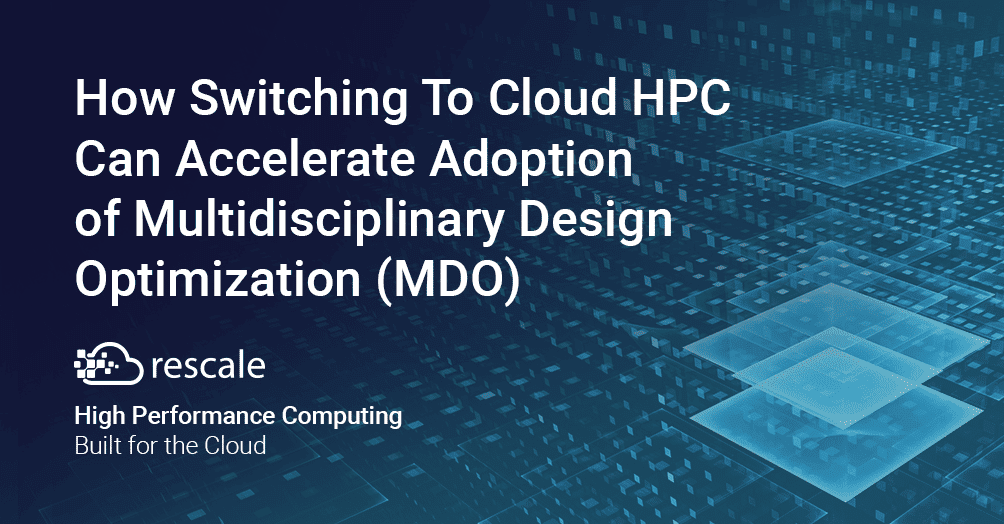How Switching To Cloud HPC Can Accelerate Adoption of Multidisciplinary Design Optimization (MDO)
Engineers will always want to run large-scale, high-fidelity simulations as often as possible. How does shifting from on-prem to cloud make dreams into reality?
Solving Problems with MDO and HPC Cloud
Multidisciplinary design optimization (MDO) uses optimization methods to solve problems by incorporating several design disciplines simultaneously. When compared with solutions derived by optimizing each discipline sequentially, leveraging MDO methods produces superior designs since it exploits the interactions between each discipline.
For example, modern aircraft such as the Airbus A350 and Boeing 787 used MDO extensively in the conceptual and preliminary design stages, and the disciplines included aerodynamics, structural analysis, weight, propulsion, flight controls, and noises, among others.
In the past, computational fluid dynamics (CFD) such as external aerodynamics analysis tended to be run in isolation, using on-prem systems, separately from structural analysis, and potentially resulted in a sub-optimal design, due to the strong coupling between aerodynamic shape and internal structures. As the MDO methodology advances, the importance of combining multiple analyses into a single simulation becomes more and more apparent. If we can achieve a better design that offers just 1% fuel efficiency improvement, potentially millions of dollars can be saved over the lifespan of an airframe – not to mention reduced CO2 emissions.

There’s a catch, though. As MDO workloads grow in complexity, naturally the computational requirements increase and the queue for HPC resources grow. From the HPC administration point of view, the high utilization rate is a sign of efficiency that maximizes the return of the on-prem HPC investment.
However, from the engineer’s point of view, the queue means frustration and delay.
And workloads only go in one direction: the desire for higher fidelity implies more complex models, larger mesh size, more load cases, etc. For on-prem systems with a three- to five-year refreshment cycle, keeping up with this kind of demand is nearly impossible, and predicting HPC usage and capacity growth is notoriously a difficult problem.
Finally, it is even more challenging when you add usage fluctuation into the mix. When your on-prem HPC is perfectly sized for the average workload and consumption needs, there is never an average day. Some days there are thousands of large jobs each requesting hundreds of cores to meet the deadlines for critical design review (CDR) or preliminary design review (PDR), other days there are none. Those fluctuations unfortunately either lead to a longer queue time for engineers or idling HPC resources.
Accelerating MDO with Cloud HPC Infrastructure
Moving workload to the cloud such as cloud services from AWS, Azure, GCP, OCI and others, can help solve many of those HPC challenges, and removes a chunk of overhead cost and administration into the bargain.
With cloud, designers and engineers can access vast compute resources at the (literal) touch of a button. The adoption of cloud is not only transforming the capabilities of established engineering design companies but also enabling challenger firms to enter the market. Freed from the delay and capital expense of on-prem systems, born-in-the-cloud companies can move fast, scale fast, and grow fast.
However, even if you’re persuaded that cloud computing offers the right path, how easy is it to make the change?
Many engineers do not have the time to learn the intricacies of HPC, Linux, and cloud computing to figure out the best configuration to run simulations as efficiently as possible. And with new compute technologies coming to market on a continuous basis, the agonies of on-prem HPC are soon replaced by the agonies of choice.
Reduce Infrastructure and Simulation Costs
At Rescale, our mission is to help our customers and partners to accelerate innovation by leveraging cloud HPC. Running large-scale MDO workloads, orchestrating different applications for each discipline and managing compute, storage, network, and related resources is itself a considerable challenge.

Organizations that use Rescale can reduce HPC infrastructure and simulation software costs per simulation, under an OPEX model. Rescale brings cloud flexibility to engineering and scientific simulations, enabling engineers to go beyond validating designs to running exploratory simulations against a broader set of variables and explore a wider design space. Lastly, Rescale delivers comprehensive visibility of operating costs across the entire HPC stack, including software licensing, infrastructure spending, and consumption by individuals and teams.
For engineers seeking to take advantage of MDO, Rescale offers the ability to easily access to a wide range of cloud infrastructures backed by AI-driven recommendation engines, and a large portfolio of engineering simulation tools deployed and optimized on the cloud. In the cloud-enabled world, running MDO workloads with Rescale enables engineers to take maximum advantage of cloud capacity, enabling more run design points at higher fidelity.
Cloud services are revolutionizing and democratizing access to HPC and adopting MDO methods in R&D. Capital investment is no longer a barrier to entry, and sophisticated orchestration services from Rescale continue to simplify and enhance the cloud experience.
For all engineering teams, switching to cloud HPC can unleash the true power of MDO, and, of course, lead to improved and optimal designs.







